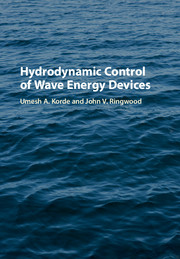Book contents
- Frontmatter
- Contents
- Preface
- Acknowledgments
- Part I Introduction
- Part II The Basics
- 2 Introduction to Control Engineering
- 3 Bodies Oscillating in Air
- 4 Bodies Oscillating in Water
- Part III The Hydrodynamics
- Part IV Velocity Control Using a Hydrodynamic Model
- Part V Control by Optimizing a Performance Index
- Part VI Toward Overall WEC System Hydrodynamic Optimization
- Part VII In Closing
- References
- Index
3 - Bodies Oscillating in Air
from Part II - The Basics
Published online by Cambridge University Press: 05 September 2016
- Frontmatter
- Contents
- Preface
- Acknowledgments
- Part I Introduction
- Part II The Basics
- 2 Introduction to Control Engineering
- 3 Bodies Oscillating in Air
- 4 Bodies Oscillating in Water
- Part III The Hydrodynamics
- Part IV Velocity Control Using a Hydrodynamic Model
- Part V Control by Optimizing a Performance Index
- Part VI Toward Overall WEC System Hydrodynamic Optimization
- Part VII In Closing
- References
- Index
Summary
Excellent discussions and examples pertaining to oscillating systems in air can be found in texts such as [58, 59]. As we have seen in Chapter 1 many wave energy conversion concepts essentially consist of moored bodies floating on the ocean surface and oscillating in response to waves. Many devices are designed (or otherwise constrained) such that motion in a particular direction dominates. We first consider such single degree of freedom devices here, as they enable us to focus just on the aspects fundamental to their dynamics and control. In calm water (absent waves, currents, or winds), such a body is in stable static equilibrium with its weight balanced by buoyancy. Any initial displacement off the equilibrium will disturb this balance, with the excess or deficit in buoyancy opposing the displacement and trying to restore equilibrium as a spring force would. Other forces would also try to oppose the body's motion; for instance, the force due to viscosity would act to damp the motion by dissipating some of its energy. Dynamic equilibrium would then require that the inertial force of the body, determined by its mass and acceleration, should balance the sum of the restoring (spring) and damping forces on the body.
Power Absorption from an Oscillatory Force
In the following, we first seek to understand the need and place for control in a hypothetical situation where the mass, spring, damping combination above are in vacuum or, for our purposes, in air. We thus ignore any forces that the air itself may apply on the mass. In the next chapter we shall consider the real situation where the body performs its motion on the water surface and begin the process of understanding of how this complicates its dynamics and any attempt to control it.
Because we have a mass and a spring, we have the basic elements necessary to set off oscillations. We suppose next that an arbitrary oscillatory force is now applied to the mass. To help develop a firm understanding, we proceed slowly and incrementally at first, and start by reviewing the dynamics underlying the transfer of power from this oscillatory force to our oscillator.
- Type
- Chapter
- Information
- Hydrodynamic Control of Wave Energy Devices , pp. 55 - 69Publisher: Cambridge University PressPrint publication year: 2016



